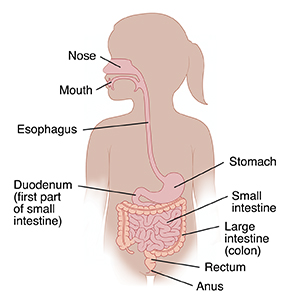When Your Child Has Gastrointestinal (GI) Bleeding
Blood in your child’s vomit or poop can be a sign of gastrointestinal (GI) bleeding. GI bleeding can be scary for you and your child. Many times, the cause of the bleeding isn't serious. But your child should always be seen by a healthcare provider if GI bleeding happens.
The GI tract
The GI tract is the path that food travels through the body. Food passes from the mouth down the esophagus. This is the tube that goes from the mouth to the stomach. Food begins to break down in the stomach. It then moves through the first part of the small intestine (duodenum). Nutrients are absorbed as food travels through the small intestine. What's left passes into the large intestine (colon) as waste. The colon removes water from the waste. Waste continues from the colon to the rectum (where poop is stored). Waste then leaves the body through the anus.

What causes GI bleeding?
Your child’s GI bleeding may have been caused by one of many different problems. These vary depending on your child's age and where you live. Some of the more common ones include:
-
Nosebleeds
-
Cuts or scrapes in the mouth or throat
-
Infection (bacteria, viruses, parasites)
-
Food allergies
-
Medicines
-
Sore (ulcer) on the lining of the GI tract
-
Swelling or irritation (inflammation) of the GI tract lining
-
Tissue growths (polyps)
-
Abnormal pouches in part of the GI tract
-
Small tears (fissures) in the anus (common in children with constipation)
-
Swollen blood vessels in the rectum (hemorrhoids)
-
One part of the bowel slides inside another part (intussusception)
-
Blood clotting problems
Blood in poop: How is the problem diagnosed?
If blood is coming out with your child’s poop, it may signal a lower digestive tract problem. Bleeding from the lower GI tract can be bright red. Or it may look dark and tarry. The healthcare provider will start by examining your child and asking questions. Your child may also need some tests, such as:
-
Blood tests
-
Hemoccult. This test checks your child’s poop for blood.
-
Stool cultures. These tests check your child’s poop for bacteria or parasites.
-
X-ray, ultrasound, MRI, or CT scan. These tests take pictures of the digestive tract.
-
Colonoscopy or sigmoidoscopy. During this test, a flexible tube with a camera is inserted through the anus into the rectum to view the inside of your child’s colon. This lets the healthcare provider do a biopsy (take a tiny tissue sample).
-
Capsule study. For this test, your child swallows a pill-sized wireless camera that sends pictures of the small intestine to a screen. The pictures are then uploaded to a computer for evaluation. The capsule is passed in the poop and flushed.
Blood in vomit: How is the problem diagnosed?
If your child is vomiting blood, it may signal an upper digestive tract problem. Your child may need certain tests, such as:
-
Endoscopy. During this test, a flexible tube with a camera is inserted through the mouth and throat to see inside the upper GI tract. This lets the healthcare provider do a biopsy (take a tiny tissue sample).
-
X-ray, ultrasound, or CT scan. These tests take pictures of the digestive tract.
-
Upper GI series. X-rays of the upper part of the GI tract are taken from inside the body.
When to call the healthcare provider
GI bleeding can sometimes be a sign of a serious problem. Call the healthcare provider right away if you notice any of these in your child:
-
Bleeding from the mouth or anus that can’t be stopped right away
-
Fever over 100.4°F (38°C) or higher, or as advised by the provider
-
Child acts very sleepy (lethargic) or is unresponsive
-
Child can't be calmed or soothed (inconsolable)
-
Child is bleeding and becomes lightheaded or dizzy
-
Fluid loss (dehydration). Symptoms include dry mouth, extreme thirst, no tears when crying, fewer than 6 wet diapers in a day, or no peeing in 6 hours. The child may also be fussy or upset.
-
Child is complaining of belly (abdominal) pain